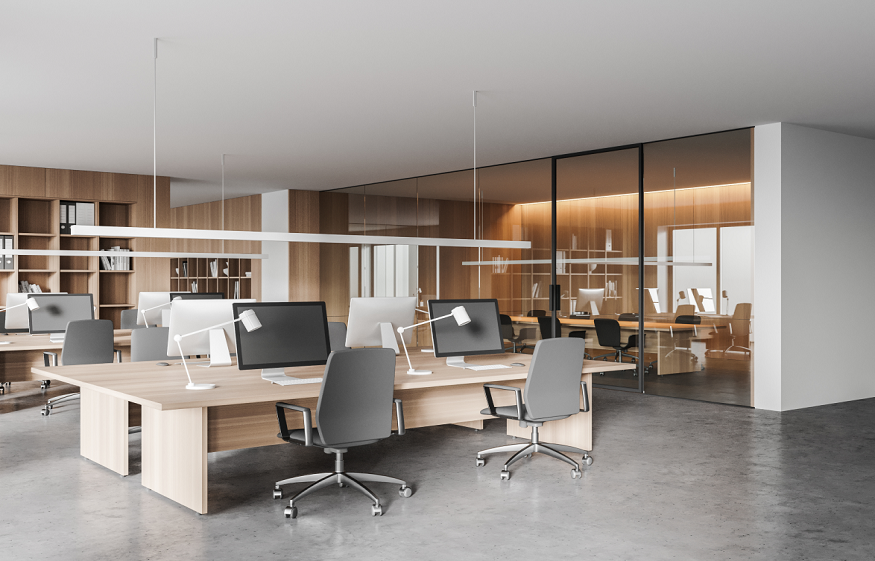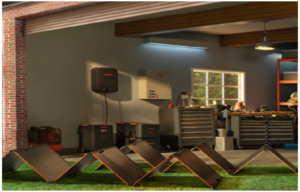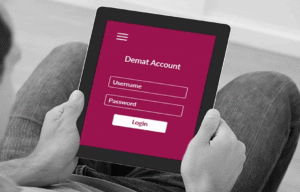Embracing Simplicity: Essential Considerations for Minimalist Office Design
4 min read
The modern corporate environment has adopted minimalist office interior design as its primary aesthetic because it brings value through essentiality and minimal decoration. The “less is more” approach of this design generates workstations that help users think clearly while removing visual distractions. A truly successful minimalist workplace requires more than dispositional work of decoration elements since proper design forms its foundation. Well-planned minimalist workplace environments establish functional harmony that creates environments which promote mental well-being while maximizing productivity and concentration. Five design principles are essential for creating minimalist office spaces which both serve their purpose and appear visually pleasing.
1.Purposeful Space Planning: Creating Functional Clarity
Intentional space planning that removes extraneous components while maintaining functional needs is the first step in creating an effective minimalist office design. Prior to making any design choices, a comprehensive evaluation of the real workflow patterns and requirements is necessary. Creating functional areas demands specialization of features along with strategizing work areas and traffic flow and natural meeting areas. Consider implementing separate workspaces for each function before adopting open-concept features as your default choice. Intentional minimalist planning requires strategic placement of work areas relative to sunlight along with obstacle elimination to maintain acoustic control and development of clear space directives. Productivity can be improved rather than hampered by aesthetic simplicity thanks to this foundation of practical clarity.
2.Quality over Quantity: Investing in Foundational Elements
Each piece is given more visual attention in minimalist design, thus the caliber of each component is very crucial. Minimalist offices benefit from having fewer, better-quality pieces that will hold up over time in terms of both beauty and utility rather than being overflowing with cheap furniture. This idea holds true for everything from wall treatments and flooring to furniture and lighting fixtures. To retain clean lines and encourage comfort and health, think about purchasing adjustable workstations and ergonomic seats. Select long-lasting, naturally aging materials over synthetic ones that could look less appealing. Well-made things with classic designs and careful workmanship are visually pleasing and eventually need fewer replacements.
3.Thoughtful Colour Strategy: Creating Psychological Balance
When it comes to minimalist office design, colour choice is quite important since it influences how people see the space and how they feel psychologically. Although white spaces are sometimes linked to minimalism, an effective colour scheme involves more than just sticking with white. Instead, think of a well-chosen neutral palette that may have subdued earth tones, warm beiges, soft whites, or gentle grays as the dominant hues. Strategic accents in a small range of tones that represent brand identity or elicit desired emotional reactions can be used to complement these. The best minimalist colour schemes take into consideration things like the amount of natural light, the size of the space, and the particular activities taking place in various places.
4.Balanced Technology Integration: Harmonizing Digital and Physical Elements
The extensive use of technology in modern offices may be at odds with minimalist ideals if it is not carefully incorporated. A room may easily become visually overcrowded with visible wires, several screens, and peripheral gadgets. This problem is addressed by effective minimalist design, which uses creative ways to preserve clean aesthetics and thoughtful preparation of technological requirements. Think of wireless technologies that minimize apparent connections, built-in charging stations, and cable management systems hidden inside furniture. Instead of scattering devices like printers and scanners over the room, assign them to designated areas. Prioritize multipurpose gadgets with simple, aesthetically pleasing designs when choosing technology. Keep in mind that technological needs change quickly, so make sure your design is adaptable to future developments without sacrificing the minimalist aesthetic.
5.Deliberate Sensory Consideration: Creating Comfortable Simplicity
Beyond only aesthetics, minimalist design incorporates all of the senses in the office. The completeness of minimalist benefits requires workplaces with simple physical appearance along with high acoustic quality coupled with comfortable temperature environments and pleasant lighting conditions. The organization and positioning of sound-absorbing materials including sound panels and ceiling treatments and textile elements should either preserve visual simplicity or enhance aural comfort based on the sound propagation pattern of open spaces. Different heights of lighting sources with various kinds should be installed for both visual depth creation and adjustable job lighting levels. Systems for controlling the temperature should provide constant comfort in the room. These sensory factors provide spaces where comfort is enhanced rather than compromised by minimalism, enabling residents to concentrate without interruptions or pain.
Conclusion
Aesthetic simplicity and useful practicality are balanced in effective minimalist office interior design through Officebanao to provide spaces that really improve the working environment. You may design a minimalist workplace that functions on several levels by concentrating on deliberate space planning, making investments in high-quality core pieces, creating a careful colour scheme, making sure that technology integrates seamlessly, and taking into account all of the environment’s sensory characteristics.
Their Whatsapp number is 8929399141. You can also send an email to inquiry@officebanao.com with your questions.







